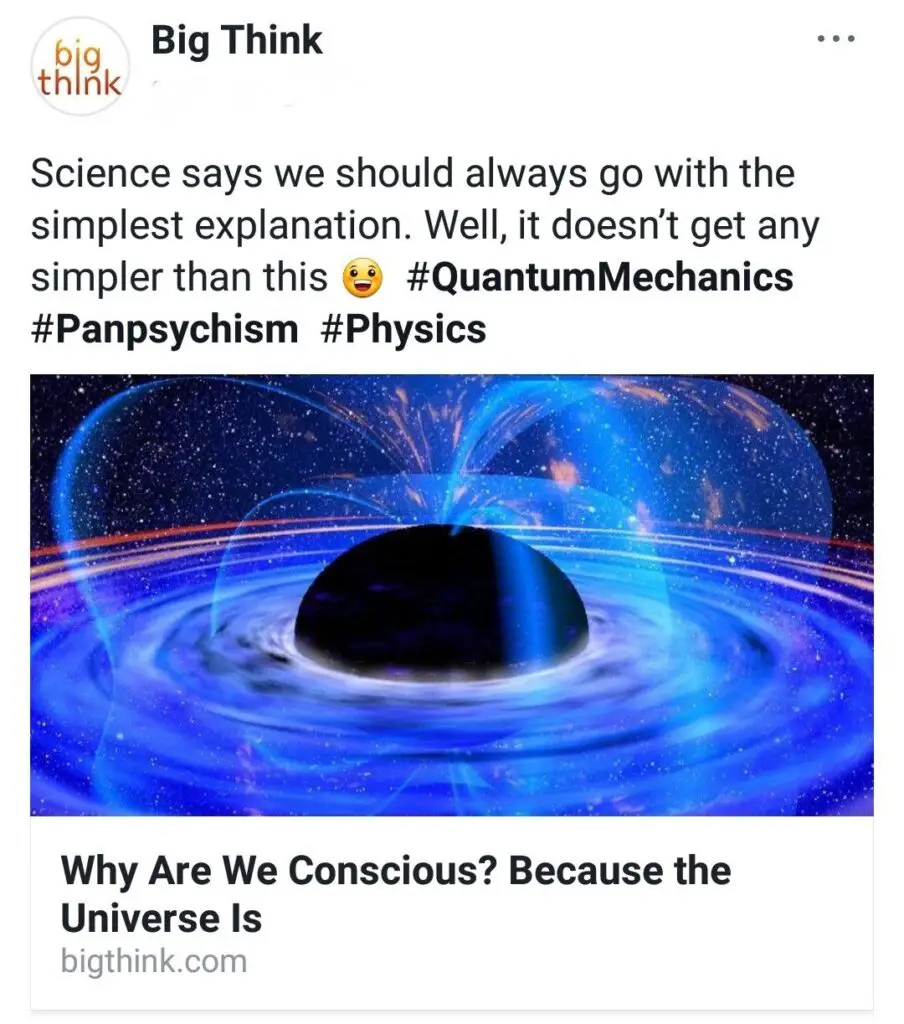Bjorn Ekeberg’s book “Metaphysical Experiments” presents an interesting “anti-realist” perspective on current physics and cosmology. The author points out how subatomic physics posits models of reality (described in terms of abstract mathematical formulas for functional interactions between entities which are themselves described, in turn, as mathematical concepts for functional interactions) instead of describing any fundamental reality to which these mathematical- functional properties belong. Physics generally, he explains , gives us abstract models for what reality is like without ever actually describing what reality IS—we don’t know, despite the intricate mathematically physical descriptions of subatomic reality, what the objects that the mathematical models describe actually ‘are’…we only know what they ‘do’ (mathematically) in relation to other models that are similarly mysterious in-themselves. The problem he notes here is an important one, and he goes on to asset that ALL the ‘objects’ of science are ALSO only models or concepts (albeit of another kind than pure mathematical ones) and ‘exist’ only insofar as the abstract methods, conceptual terms and epistemic/metaphysical assumptions that science imposes on living experience, bring them into being via a self-referentially circular logic:
“We can see the implicit circularity of modern cosmology and advanced particle physics. Experiments are primarily set up to find evidence for predetermined, hypothetized criteria, and the complicated nature of the experiments …. this means that it’s not possible to ‘simply observe’ what happens—rather, the results of the experiment are interpreted in light of the theoretical framework within which the experiment is given meaning in the first place.”
As the western skeptical tradition from the ancient Sextus Empiricus to Hume’s critique of induction to the ‘constructive empiricism’ of Van Frassen (as well as an analytic tradition from Russell/Whitehead to Putnam/Goodman), and the Asian ‘anti-realist’ legacy in Mahayana Buddhism from Nagarjuna to Nishitani have long understood, the very idea that there is an objective reality composed of substantial physical objects existing independently of the conscious observer, is a nebulous and problematic “metaphysical” ideal…..one that our current science may assume but can never demonstrate scientifically (McMullin’s “From Matter to Materialism” and Clayton’s “Unsolved Dilemmas The Concept of Matter in the History of Philosophy and Physics” in Davies’ Information and the Nature of Reality provide two good historical surveys of how elusive and mysterious the scientific concept of both ‘matter’ and the ‘objective’ physical World on which conceptions of matter have been based, has always been). Indeed, matter—like space-time, fundamental forces, constants and physical laws, etc.— may be a useful conceptual construct for articulating scientific theories, but difficult to prove as an objectively real feature of a theory/mind- independent reality.
Panpsychism, a school of thought in metaphysics and consciousness-studies with a long and substantial legacy around the world, may go a long way toward resolving this dilemma. Every civilization, from the most primal to the most complex, and from prehistory through the present, has a philosophical and/or religious tradition predicated upon a panpsychist worldview. In fact, most classical intellectual traditions are at least to some extent panpsychist in nature, and even tough-minded empirical contemporary western philosophy, psychology, cognitive science and physics only became metaphysically materialistic (to the exclusion of panpsychism) over the last few hundred years. Nonetheless, the intellectual milieu of post-enlightenment western society during this time has become so thoroughly grounded in scientific materialism (also called “physicalism”), that the very idea of panpsychism in any field of knowledge has been largely relegated to the realm of myth. Only over the past few decades has panpsychism begun to re-emerge as an important, cutting-edge theory influencing ideas across philosophy, religion and the behavioral-physical sciences. Its status as a countervailing theory to the predominant scientific materialism means that any justification for its legitimacy must address scientific materialism to begin with (panpsychism is the theory that consciousness is a fundamental –in some versions of panpsychism, THE fundamental– property or feature of the universe, in addition to, or perhaps as foundational to, basic physical-material properties like space-time, gravity, matter, laws of physics, etc.).
One important and clearly articulated article by Sam Coleman makes a particularly succinct and effective analytic case for panpsychism. Among other things, the article develops a convincing (if not exactly original) argument to support the claim that panpsychism is true, while also preserving the ontological integrity of scientific realism—if not scientific materialism:
- As Bertrand Russell, Sir Author Eddington, and many other more recent preeminent physicists and philosophers of science have pointed out, physics (the foundational branch of science) despite its precision and accuracy in describing reality, is limited to quantitative descriptions of what physical objects and forces abstractly DO, rather than providing qualitative descriptions of what they intrinsically ARE—which science cannot accomplish with the tools it utilizes. Physics only accesses reality ‘from the outside’, in terms of its outward behaviors but not in terms of its essential nature. This is true down to the most basic level of physical reality. As Eckberg notes in Metaphysical Experiments:
“precision experiments in high energy physics concluded that the electron is a so called point particle—it possesses no structure beyond what the theories of quantum mechanics and relativity demand for their conceptual coherence”
2. What’s missing from the physical-scientific perspective therefore, is reality’s inner, intrinsic nature: the essence of what the objects and forces (whose outward behavior the physical sciences describe) actually are in-themselves –the basic substance without which the physical properties described by science would not exist because they’d have no foundational entity or essence to be properties of.
3. Thus, for a complete understanding of reality, we must look beyond, or deeper than, what the physical sciences can provide. We need to understand what the essential nature of physical reality is—the basic essence beyond (or beneath) the physical world. The foundational inner world to which physical properties, forces, and laws belong.
4. This essence would have to be something absolutely self-evident, self-referential, and self-sustaining—having no foundation upon which it depends for its existence, and requiring nothing more basic than itself upon which its existence depends. (like Aristotle’s ‘Prime mover’ or categories of predication, Leibniz’s ‘Principle of Sufficient Reason’, or the ‘first, uncaused cause’ of the Cosmological Argument). Physical chains of causal, empirical, or scientific explanation have no ‘first causes’ since they must always be explicable in terms of prior causes or explanations. They only exist as secondary properties. However, existence can’t rationally be an infinite regress—Properties must rest on, and explanations have to stop at, some foundational explanation that is self-referentially justified and requires no justification outside of itself.
–WHAT ASPECT OF REALITY COULD PROVIDE THIS KIND OF FOUNDATION?–
5. The existence of all physical objects, properties, events and forces must be caused or contingent (dependent) upon other, more basic, physical elements for their existence (there are no non-contingent, self-sustaining aspects of physical reality since every physical entity or event is contingent upon or derived from a more basic fundamental entity or event which is, or is responsible for, causing it.)
6. However, as Rene Descartes noted, the one aspect of reality that IS absolutely self-sustaining and self-referentially justified, is non-physical consciousness (the qualitative experience of subjective awareness or the experience ‘what-it’s-like-to-be’ …. Descartes’ “I think therefore, I am”). Consciousness is the only immediate an immanent aspect of reality—experienced first-hand, from the inside, or from immediate direct experience — that requires no other verification beyond its self-evident presence to prove its existence (conscious experience does not have to be objectively perceived and identified for us to know it exists—we know it because we ARE it). In fact, the operations we need to perform to perceive and identify all other things in the world (sense perception, labels, analysis, quantification, evaluation, etc) are already part of conscious experience—so consciousness is already the foundation of the rest of the world as we apprehend it, because this apprehension is built from conscious operations. Everything else in the physical world is only identified and understood (second hand) via the sense-perception and conceptualization (labels, explanations, justifications) in consciousness.
7. Therefore, consciousness is the sole candidate for the basic inner qualitative essence of reality –which we perceive from the outside as the physical world. Consciousness is the inner qualitative essence of what appears to us, when we look at it from the outside, scientifically, quantitatively, as the physical universe. Science, quantification, and the physical itself, are all concepts about reality that emerge in and through consciousness.
8. Hence, consciousness would, logically, appear to be intrinsic or essential to the physical universe, as panpsychism claims. As Goff claims:
“So it turns out there is this huge hole in our scientific story of the universe. We learn from physics a lot about what matters does – its behaviour – but we don’t know what it really is. So there is this huge hole: the proposal of the panpsychist is to fill that hole with consciousness. …matter as it were, from the inside – in terms of its intrinsic nature – is constituted as forms of consciousness, therefore, it’s this beautifully simple, elegant way of bringing together what science tells us from the outside and what we know about ourselves from the inside.”
There are any number of problems that panpsychism entails, most of which concern its adherence to scientific materialism even as it attempts to transcend materialism’s short-comings. Among these are the “combination problem” –how consciousness is somehow ‘housed’ in the material world. Are there ‘bits’ of consciousness in every chemical substance, cell, atom and subatomic particle, and how would this work? How would these arrange themselves if –given the insubstantiality of matter as demonstrated by the transformation and malleability of the very concept of matter from ancient Greek science through current quantum physics—matter HAS no clear arrangement? Moreover how would these bits of consciousness combine to form what we know of as complex awareness? Also, panpsychism seems to perpetuate the original “mind-body relationship” problem (how are the two apparently different phenomenon of consciousness and the physical world related, and how can consciousness possible ‘arise’ from the physical world as scientific materialism has dubiously claimed?), which it was initially proposed to solve….
Still panpsychism as understood via this argument is at least a creative and novel attempt to, if not ‘re-enchant the world’, at least reincorporate consciousness into the fabric of reality, reunite mind and the body, and reconcile the complexity of objective empirical data with the subjective depth and vitality of living experience.
We hope you enjoy our articles. Please note, we may collect a share of sales or other compensation from the links on this page. Thank you if you use our links, we really appreciate it!



